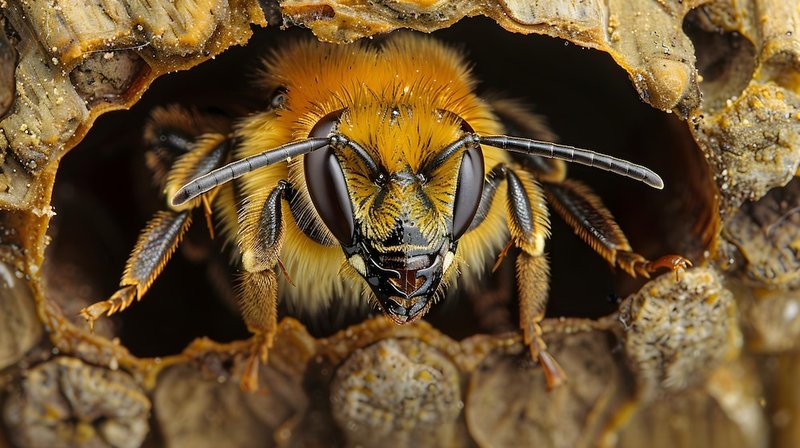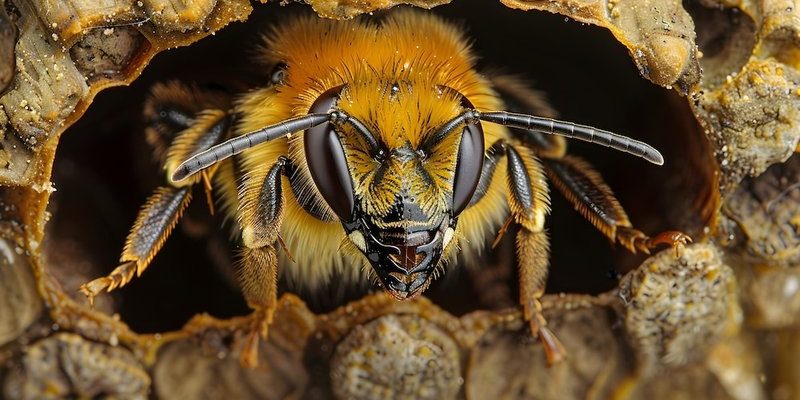
Understanding the habitat and nesting behavior of the mason bee can help us appreciate their vital role in our ecosystems. Here’s the thing: mason bees are exceptional pollinators, and they can enhance gardens and farms by helping to grow fruits and vegetables. So, in this article, we’ll dig deeper into where these bees live, how they build their nests, and why caring for them is important for our environment.
The Natural Habitat of Mason Bees
Mason bees thrive in various habitats, with a strong preference for areas rich in flowering plants. You might find them buzzing around gardens, orchards, and wildflower meadows. These environments provide not only the food they need—pollen and nectar—but also suitable nesting sites. Essentially, mason bees are drawn to locations where they can find both sustenance and a bit of privacy to build their homes.
Unlike honeybees, which require large colonies, mason bees can do quite well on their own. They often favor habitats that offer natural resources like mud, clay, or even plant stems for nest construction. You might be wondering why they need these materials. Well, mason bees use mud to seal their eggs and create compartments within their nests. So, their ideal habitat is a mix of food availability and building materials.
Another key aspect of their habitat is sunlight. Mason bees are active during the day and prefer sunny spots over shady areas. You’ll often spot them working hard on warm spring days, visiting flowers in search of pollen. If you’re looking to attract these bees to your garden, planting a variety of native flowers and allowing a little area for mud or bare soil can create a welcoming environment.
How Mason Bees Build Their Nests
Mason bees are known for their unique nesting behaviors, which can vary depending on the species. Generally, females are the builders, and they take on the task of creating nests in small, pre-existing holes or tubes. These can be found in dead wood, hollow stems, or even in the soft mortar of brickwork. It’s a bit like finding a cozy nook in a bustling city to call home.
Once a female mason bee identifies a suitable site, she gets to work. She gathers pollen and nectar, forming a food ball that she places at the bottom of the nest. After laying her egg on top of this food source, she seals the chamber with a mud wall. This process is repeated, creating multiple compartments within the same nest. It’s like building an apartment complex—each room designed for a new generation of bees.
Interestingly, some mason bees will even create a sort of “coat” for their eggs. They mix pollen with their saliva to form a protective layer, ensuring that the future bees are well-fed and shielded from the elements. This method shows just how dedicated they are to the survival of their offspring.
The Role of Mud in Nest Construction
Mud is crucial to the nesting success of mason bees. It serves multiple purposes, primarily as a building material for sealing their nests. It’s fascinating to think about: these tiny creatures utilize natural resources to meticulously construct their homes. When you see a mason bee collecting mud, it’s like watching an artist gather the perfect paint for her masterpiece.
The mud needs to be just right—not too dry or too wet. If it’s too dry, it won’t stick together, and if it’s too wet, it could collapse. This clever construction technique showcases the bees’ ability to adapt to their environment. They often choose nesting sites close to water sources, which makes mud collection easier.
In urban settings, mason bees can adapt remarkably well. They might find mud in flowerpots, garden beds, or even puddles after a rainstorm. This adaptability allows them to flourish in various environments, making them excellent allies for city gardeners looking to enhance pollination.
Nesting Behavior Across Seasons
Mason bees have a life cycle closely tied to the seasons. In spring, when the weather warms up, adult mason bees emerge from their nests. They quickly get to work, pollinating flowers and preparing for the next generation. You might see them buzzing busily around blooming plants, with each female focused on her mission.
As the nesting season progresses, females continue to gather pollen and construct their nests. By summer, they’ll finish laying eggs, and the new generation will begin developing. Here’s the thing: these eggs won’t hatch until the next spring, allowing them to survive winter in their cozy mud-sealed compartments.
During winter, the adult bees remain dormant in their nests, shielded by the mud walls. They rely on the insulation of the surrounding materials to survive cold temperatures. This smart strategy helps ensure their species continues year after year, as they emerge just in time for the next flowering season.
Creating a Mason Bee-Friendly Environment
If you want to attract mason bees and support their nesting habits, creating a friendly environment is key. Start by planting a diverse range of native flowers that bloom throughout the spring and summer. Choose plants like lavender, willows, and fruit trees, as they provide essential food sources for these pollinators.
Additionally, consider providing nesting sites. You can create bee hotels by bundling up hollow stems or drilling small holes in untreated wood. These artificial nests mimic natural environments and offer mason bees a safe place to lay their eggs. Position the hotels in sunny spots, ideally facing south or southeast to attract the bees’ interest.
Another important tip is to leave a little bare soil or mud in your garden. Mason bees need these materials for nest building, so allowing some areas of your garden to remain undisturbed can be beneficial. Just imagine: a little patch of bare soil can transform into a bustling bee neighborhood.
Why Mason Bees Matter
Mason bees are more than just fascinating creatures; they’re vital for our ecosystems. They play a significant role in pollination, helping fruits, vegetables, and flowers to thrive. By effectively transferring pollen from one bloom to another, they enhance crop yields and biodiversity.
Honoring these hardworking insects means we can help ensure food security and a healthy environment. Their efficient pollinating capabilities often make them even more effective than honeybees, especially for certain types of plants that they visit more frequently.
By nurturing mason bees in our gardens and communities, we contribute to the well-being of our planet. Plus, it’s a joyous experience to see these tiny powerhouses hard at work. Supporting mason bees can create a ripple effect, benefiting everything from local gardens to far-reaching ecosystems.
In conclusion, understanding the habitat and nesting behavior of mason bees gives us a deeper appreciation for their role in nature. By providing a safe and welcoming environment, we can help these remarkable little bees thrive and continue their crucial work as pollinators. So, whether you’re planting new flowers or building a cozy little bee hotel, every effort counts towards supporting these amazing creatures.

